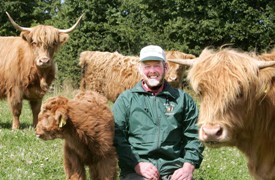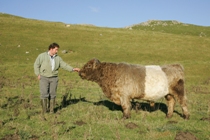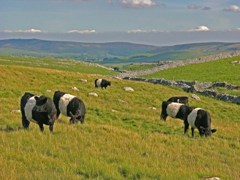Links and local information for Malham, North Yorkshire UK
Limestone Country Beef Project
What is the project/who are we? The Yorkshire Dales National Park contains eight special sites that have been recognised as being internationally important for their outstanding geology, unique habitats and exceptional plant and wildlife. These sites have been combined into two areas, the Ingleborough and Craven complexes, which have been designated Special Areas of Conservation (SAC). The areas include key features such as the Malham Tarn wetland and Ingleborough national nature reserves (NNR).
In the past, much of this limestone country has been mis-managed resulting in the decline and loss of some habitats and species. The Limestone Country Project aims to restore these habitats to a favourable condition by encouraging appropriate land management practices. The project supports a return to mixed farming using hardy upland breeds of cattle and whole-farm management plans.
Limestone Country Project is a partnership between the farming community, landowners, conservation organisations, and local experts working together with funding from the European Commission LIFE Fund.

What is Limestone Country? The internationally important limestone country of the Yorkshire Dales National Park is concentrated in the uplands around Ingleborough, Malham and Wharfedale. The Carboniferous rock of the limestone pavements is made from the shells of marine animals existing 300 million years ago, and 50% of the UK’s limestone pavement is found in the Yorkshire Dales. The soil overlying this rock is usually very thin and of low fertility and in combination with managed grazing results in a rich diversity of lime-loving grasses and wildflowers. The springs and the fens in the area give rise to unique vegetation associated with wet lime-rich ground. Limestone Pavement is a declining resource of international conservation importance.
Why is the Limestone Country important? The project area is the nation’s most important limestone landscape. The mosaic of habitats includes the most extensive area of upland semi-natural dry grassland and limestone pavement in the UK. Not only limestone pavement, but also flushes and springs, calcareous grassland, woodland and scrub, rock outcrops and screes, and lime-rich natural lakes. These habitats are home to a diverse range of plants and animals, some of which are only found in this landscape. The nationally scarce bird’s eye primrose and rigid buckler fern are unique to limestone country, as well as it being a stronghold for interesting species such as rock rose, blue-moor grass and the northern brown argus butterfly.
This special landscape has taken thousands of years to form, but is now under threat as a result of quarrying and unsuitable farming methods. This project aims to rejuvenate and restore limestone country through better land management and conservation.
Threats to Limestone habitats A number of activities over recent years have threatened to damage or even destroy the habitats present in the project area, and many threats are influenced by and impact on each other.
Livestock grazing has been the main influence on the wildlife habitats of the uplands for centuries. However a sharp increase in sheep stock since the 1950s has reduced in number the herbaceous plants characteristic to this area.
With farming intensification additional pressure has been put on the limestone uplands, as some accessible limestone pastures have been fertilised to increase grazing for higher numbers of stock and also to maintain larger modern cattle breeds. Bought-in feed, to help maintain stock condition, has also resulted in damage to grassland by introducing foreign species.
The move away from mixed livestock farming and towards specialised sheep farming in the last 50 years has led to significant losses in species and structural diversity as sheep are highly selective grazers and select the most palatable species. The loss of cattle, which are less selective grazers, has resulted in rank vegetation remaining ungrazed.
In the past a major threat to limestone pavement has been removal of surface limestone
for use in decorative rockeries. This has now been addressed with protective legislation, but still remains threatened by localised removal of stone by visitors. A pavement survey revealed that of the 600 pavement areas in the UK only 3% are entirely undamaged (Ward and Evans, 1976).
Difficult to control invasive species such as thistles are having a detrimental impact on the area, as are dense rabbit populations as burrowing causes slope erosion and intense grazing restricts plant regeneration.
Other factors such as foot and mouth, pollution, recreational pressures in particular from four-wheel drive vehicles, and modification of woodlands through planting of non-native species, have all contributed to the decline of the limestone landscape.

Habitats/Map
Conistone Old Pasture consists of expanses of species-rich limestone pasture interspersed with extensive limestone pavements. Alpine cinquefoil and dropwort are found, as well as a large population of the northern brown Argus butterfly. The pavements, scars and dry meltwater channel (Conistone Dibb) to the north are of national geological importance. (50)
Kilnsey Flush is a small area of fen, which is flushed with lime-rich water. It is one of the richest fen sites in the Yorkshire Dales and supports a large population of bird’s-eye primrose and marsh helleborine. (37)
Bastow Wood comprises an area of ash-hazel wood pasture, a rare habitat in the Yorkshire Dales. Under the scattered tree cover are species-rich limestone grasslands with abundant bloody crane’s-bill and rockrose. (31)
Malham-Arncliffe is an outstanding site of nationally important limestone features and cave systems. Species-rich limestone pasture is interspersed with extensive areas of limestone pavements, supporting plants usually confined to woodlands, such as baneberry and angular Solomon’s-seal. The grasslands are dominated by blue moor-grass and areas flushed with lime-rich water have the local speciality, bird’s-eye primrose. The site includes one of the most outstanding wetland complexes in the UK, centred on Malham Tarn (72).
Cool Pasture is a small limestone pasture, which adjoins the larger Malham-Arncliffe site. The grasslands are largely unimproved and support a diverse range of plant species including moonwort, autumn gentian and limestone bedstraw. (33)
Ingleborough is notable for extensive limestone pavements, dry valleys, sinkholes and caves. The range of rocks along with the peat and glacial drift covering the site result in a diversity of vegetation types. The limestone pavements of Colt Park and Scar Close support limestone polypody and globeflower, while the higher crags are populated by arctic-alpines. (56)
Whernside represents one of the most important limestone areas in the Yorkshire Dales. The extensive limestone pavements on Scales support within their grikes (fissures) notable species such as baneberry, lesser meadow-rue and rigid buckler fern. (36)
Oxenber and Wharfe Woods sit on a limestone knoll to the south east of Ingleborough. The site is predominantly grazed wood pasture with a notable population of spurge laurel. Limestone pavements on the plateau contain northern bedstraw and mountain melick. (39)
What will the project do? The diversity of over 1500ha of habitats will be restored and enhanced by converting farming enterprises to more appropriate mixed livestock systems; Grants will be provided to establish upland hardy cattle breeds, which were originally responsible for creating and maintaining the mosaics of habitats in the area. Up to 20 whole farm management plans will be established.
Invasive plant species such as thistles & bracken, and rabbit grazing will be controlled by environmentally sensitive means over 1000 hectares of land of high nature conservation importance.
The Ingleborough and Malham Tarn National Nature Reserve Management Plans will be revised to reflect the use of upland hardy cattle breeds in the grazing regimes of these two reserves. Malham Tarn Fen will also be managed through a programme of scrub cutting. To promote better understanding of the nature conservation benefits of different cattle systems, a programme of surveys and research projects has been established. A survey of the ecological condition of the project area was completed at the start of the project and will be carried out again in 4 years time to assess its overall impact of the project.
A detailed research project to compare the effects of grazing with sheep only, mixed sheep and upland hardy cattle breeds and cattle only on the habitats will also be developed as will research to determine how the switch to grazing with upland hardy cattle breeds affects the economic performance of the farms.
A computer database will be developed for recording ecological condition, land use, land ownership and stock management in the project area.
To increase awareness and understanding of environmentally and economically sustainable conservation management at a local, national & international level, a programme of publicity, events/materials and on site interpretation will be made available.
Demonstration events in the area will be held to promote best practice techniques in managing conservation sites using upland cattle breeds.

Project Partners The Limestone Country Project is a partnership involving the Yorkshire Dales National Park Authority, English Nature, The National Trust, Grazing Animals Project, Rare Breeds Survival Trust, National Beef Association, and landowners and the farming community.
The Yorkshire Dales National Park is a government body which has a duty to conserve and enhance the natural beauty, wildlife and cultural heritage of the Yorkshire Dales, promote opportunities for the understanding and enjoyment of the special qualities of the National Park, and to foster the economic and social well-being of local communities within the National Park.
English Nature is the statutory body, which achieves, enables and promotes nature conservation in England. It does this by working in partnership with individuals and a wide range of organisations including Government representative bodies, agencies and voluntary organisations.
Grazing Animal Project (GAP) helps deliver biodiversity targets as part of integrated, viable and sustainable grazing systems throughout the UK. GAP conceived and promoted the idea of Local Grazing Schemes (LGS) in which conservation bodies work together with the livestock industry to organise, rationalise and help deliver grazing that will benefit wildlife within a specific locality.
Rare Breeds Survival Trust (RBST) was founded in 1973 and works together with scientists, volunteers and breed societies to protect and conserve Britain’s traditional breeds of farm livestock. It is not supported by Government funding.
National Beef Association (NBA) is an independent body representing the
interests of UK beef farmers, and which aims to resolve a broad band of issues of current concern to beef producers.
The European Union’s Life Fund provides funds for nature conservation work on Europe’s most important wildlife sites, the Special Areas of Conservation and Special Protection Areas.
For more information about the Limestone Country Project contact;
Project Officer – Louise Williams, Yorkshire Dales National Park, Colvend, Grassington.
Tel: 01756 752748, E-mail: limestone-country@yorkshiredales.org.uk
Limestone Country Brochure Download Brochure Here
and also the Final Limestone Project Report from here
Limestone Beef is available from :-
- Paganum Yorkshire Dales Farmers Market Kirkby Malham
- Town End Farm Shop Airton, Nr Malham
- Colin Robinson Family Butcher in Grassington, Nr Skipton.
- Food & Drink
- Walking around Malham
Please mention malhamdale.com when calling.
Want to keep in touch with occasional special events & offers? then please Subscribe to the Malhamdale Newsletter